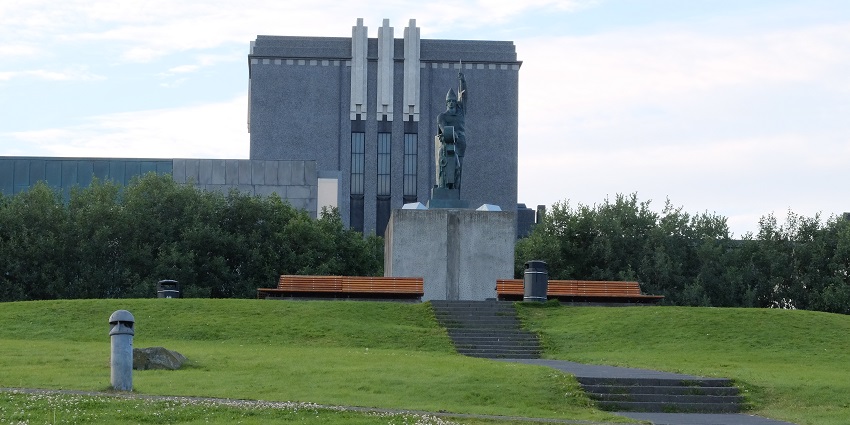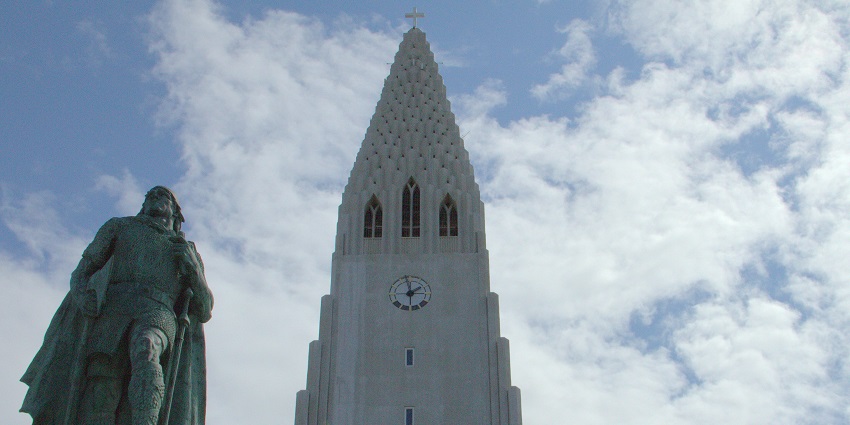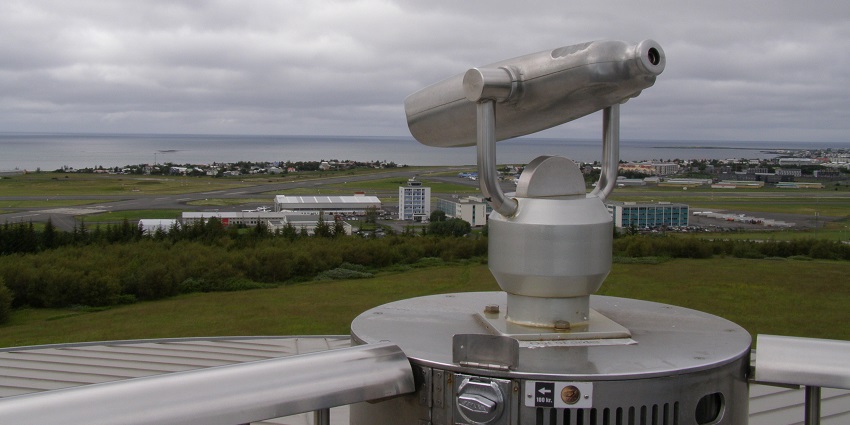From striking sculptures that define Reykjavik’s skyline to mournful memorials strewn across vast lava plains, monuments in Iceland mirror the nation’s history, artistry, and idiosyncratic identity. Iceland, despite having few inhabitants, features several noteworthy monuments. These structures pay homage to the country’s Viking ancestry, commemorate national heroes, and display singular expressions of Icelandic artistry. Whether situated within urban centres or in remote, rural landscapes, these monuments offer valuable insights into the identity and collective memory of this Nordic island nation.
12 Iconic Monuments In Iceland
Here is a list of prominent monuments in Iceland that bear the imprint of the great and ancient Viking heritage.
1. Sun Voyager (Sólfar)

Photo: Guilhem Vellut / Wikimedia Commons
The Sun Voyager (Sólfar) is a beautiful piece of steel sculpture set on the scenic waterfront in Reykjavík, created by Jón Gunnar Árnason from Iceland. This symbolic monument is often mistaken for a Viking ship, but in reality, it is a dreamboat, an ode to the sun and to the promise of newfound lands, freedom, and progress. Set against the splendour of Mount Esja and the azure waters of Faxaflói Bay, it’s simply exquisite, especially at sunset when the sun’s golden rays bathe the entire structure in light.
Timings: 24*7
2. Jón Sigurðsson Monument

Photo: Bryan Ledgard / Wikimedia Commons
Located in front of the Parliament House in Reykjavík, the monument is dedicated to Jón Sigurðsson, herald of Iceland’s 19th-century independence effort. Designed by the sculptor Einar Jónsson and unveiled in 1911, the statue presents Jón Sigurðsson in one hand with a book, standing resolutely in accordance with his role in the shaping of Icelandic national identity. He is recognised for his unyielding efforts to achieve a measure of autonomy for Iceland from Danish rule. Carvings on the base of the monument symbolically show elements of the cultural and political awakening of Iceland.
Timings: 24*7
3. Ingólfur Arnarson Statue

Photo: Ziko van Dijk / Wikimedia Commons
The Ingólfur Arnarson statue stands atop Arnarhóll in Reykjavík, honouring Iceland’s first Norse permanent settler. Cast in 1924 in bronze and designed by Einar Jónsson, the statue shows Ingólfur with a spear next to his high seat pillars, which were actually his claim to the land. According to the legend, Ingólfur threw the pillars into the sea and settled wherever they washed ashore, erecting his first home on the site of today’s Reykjavík. The site of the statue is high above downtown Reykjavík, affording views and a symbolic reminder of the Viking heritage of Iceland.
Timings: 24*7
4. Leif Erikson Monument

Photo: Helgi Halldórsson / Wikimedia Commons
The Leif Erikson Monument, prominently situated before Hallgrímskirkja Church in Reykjavík, honours the Norse explorer who is said to be the first European to set foot in North America around 1000 AD, about 500 years earlier than Columbus. This notable sculpture was presented to Iceland by the United States in 1930, marking the millennium anniversary of the Althing, Iceland’s historic parliament. The sculpture was designed by Alexander Stirling Calder and portrays Leif Erikson looking confidently westward, symbolising discovery and courage. The monument itself stands on top of a tall stone pedestal, adding to its prominence in Iceland’s capital.
Timings: 24*7
5. The Unknown Bureaucrat

Photo: Ray Swi-hymn / Wikimedia Commons
Hidden in the city centre of Reykjavik by Lake Tjörnin, The Unknown Bureaucrat is a vivid exhibit of contemporary public art and one of Iceland’s more unusual monuments. Designed by sculptor Magnús Tómasson in 1994, the statue is a faceless suit-clad civil servant whose upper half is human but whose lower half consists of an unshapen block of basalt. This incomplete version represents the oft-neglected, faceless status of bureaucratic positions in society. In contrast to heroic statues, it is a tongue-in-cheek, ironic depiction of the contemporary workforce and, for this reason, a favourite among locals and visitors alike.
Timings: 24*7
6. Einar Jónsson Statue Garden

Photo: Kvaale / Wikimedia Commons
In Reykjavík, the Einar Jónsson Statue Garden highlights with great beauty the art and cultural background of Iceland. Behind the Einar Jónsson Museum, visitors can find an outdoor park with over 20 bronze and stone art pieces made by Iceland’s first sculptor, Einar Jónsson. Each statue represents subjects from Norse mythology, the beliefs of Icelandic people and stories from folklore. People visiting the museum can wander the quiet area at no cost to admire the mixture of romanticism and national pride shown in Jónsson’s design.
Timings: 24*7
7. Hofskirkja Turf Church

Photo: Xfigpower / Wikimedia Commons
In the Öræfi region of Iceland, 3 kilometres south of Kirkjubæjarklaustur, Hofskirkja Turf Church is the last turf church constructed in Iceland. This small church was built in 1884 in honour of Saint Clement and shows true Icelandic tradition, thanks to its grass roof and walls made of earth. The Lutheran parish continues to hold their religious services at this church today. Hofskirkja is visible from the massive Vatnajökull mountains and is set next to an old graveyard, so it gives a special view into Iceland’s religious and architectural past.
Timings: 9 AM – 6 PM
8. Hallgrímskirkja

Photo: Hyppolyte de Saint-Rambert / Wikimedia Commons
You can see Iceland’s tallest church, Hallgrímskirkja, towering over Reykjavik and making the city’s skyline distinctive. The building stands 74.5 metres (244 feet) tall and was designed by architect Guðjón Samúelsson, who took his inspiration from the columnar basalt that results from cooling lava flows. The project started in 1945, and after 41 years, construction was finally completed in 1986. People gather in the church to worship thanks to its association with Hallgrímur Pétursson, a famous 17th-century Icelandic poet and religious leader. The organ inside is a grand 15-metre one designed by Johannes Klais from Bonn, Germany.
Timings: 9 AM – 8 PM
9. Reykjavík Art Museum

Photo: TommyBee / Wikimedia Commons
Reykjavík Art Museum Ásmundarsafn celebrates the life and work of Icelandic sculptor Ásmundur Sveinsson. Uniquely, the museum occupies the artist’s former residence and studio in Laugardalur, an architectural marvel reflecting influences from both Middle Eastern and Mediterranean traditions alongside local sensibilities. In the museum, you can see the strong sculptures made by Sigurður, which are inspired by Icelandic tales, the country’s workforce and living beings, giving great insight into the country’s art scene in the last century.
Timings: 10 AM – 5 PM (May to September) and 1 PM – 5 PM (October to April)
Entry Fees: kr 2,430 / ₹1,470 for adults and kr 1,500 / ₹900 for students
10. Grótta Island Lighthouse

Photo: Olga Ernst / Wikimedia Commons
Grótta Island Lighthouse is famous for being a historic monument found close to Reykjavik on the small peninsula of Grótta. Since it was built in 1897, this lighthouse has led ships safely past the North Atlantic’s harsh waters for over a century. Because the island is accessible on foot at low tide, the lighthouse draws crowds of both locals and tourists. Those who visit often enjoy watching the ocean and the area’s birds and observing the Northern Lights between fall and winter. You should visit Grótta Island Lighthouse because the calm setting and its history make it unique in Iceland.
Timings: 24*7
11. Perlan

Photo: RG72 / Wikimedia Commons
Perlan is one of Iceland’s most impressive monuments and is found in Reykjavík. This modern glass dome is placed upon six enormous water tanks and provides unobstructed views of the city and surrounding areas. Perlan contains the Wonders of Iceland exhibit with a man-made ice cave, interactive information about volcanoes, glaciers, and geothermal power, and Iceland’s distinctive natural marvels. Perlan also includes a revolving restaurant (with an excellent Icelandic menu) that allows diners to experience full 360-degree views during their meals. Perlan combines sleek architecture with Iceland’s emphasis on sustainability, as it runs on geothermal energy for heat and air conditioning.
Timings: 10 AM – 6 PM
Entry Fees: kr 4,700 / ₹2,850 for adults and kr 2,200 / ₹1,330 for children
12. Imagine Peace Tower

Photo: Abdullah Efe / Pexels / Image For Representation Only
The Imagine Peace Tower is a significant monument in Iceland dedicated to peace by artist Yoko Ono, in memory of Beatles member John Lennon, who was her husband. The monument is located on Viðey Island, which is located off the coast of Reykjavík. The tower produces a vertical beam of light reaching 4,000 metres into the sky and is lit every year from October 9th (Lennon’s birthday) until December 8th (the day of his assassination), in addition to other specific dates for world peace promotion. The base of the monument features the words “Imagine Peace” in a total of 24 different languages to represent national cooperation and peaceful gestures.
Timings: Oct 9 to Dec 8
Entry Fees: kr 2,300 / ₹1,390 for adults and kr 1,150 / ₹695
When you look at monuments in Iceland, you see that they are telling the stories of Iceland, carved in rock and metal. From showing respect for early Icelandic settlers and valued figures of history to displaying modern expressions, these monuments represent Iceland’s story through different times. Plan a trip with TripXL and enjoy special experiences.
Cover Photo: Truba7113 / Shutterstock


 WhatsApp
WhatsApp
 Twitter
Twitter









